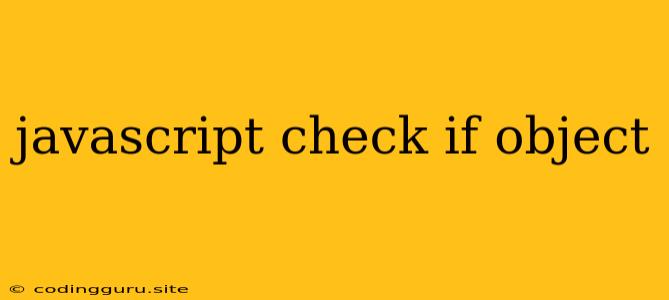Understanding Object Existence in JavaScript
In JavaScript, working with objects is fundamental. Objects hold data in key-value pairs, offering a structured way to represent information. But, how do you know if an object exists in your code? This is where the concept of checking for object existence comes into play.
The Importance of Checking
Why is it crucial to check if an object exists before using it? Let's consider a few scenarios:
- Avoiding Errors: Accessing a non-existent object property can lead to a dreaded
TypeError: Cannot read property '...' of undefined. This is a common pitfall that can disrupt your code's flow. - Conditional Logic: You might want to execute certain code only if an object is available. For example, you may have a function that processes data from a database, but you only want to run it if the database connection has been established.
- Improving Code Readability: Explicitly checking for object existence makes your code more understandable and less prone to errors.
Methods for Checking Object Existence
Here are some effective ways to check if an object exists in JavaScript:
1. The typeof Operator
The typeof operator returns the type of a variable. It can be useful for checking if a variable is an object or not. However, be careful! typeof returns 'object' for both objects and arrays.
let myObject = { name: "Alice" };
let myArray = [1, 2, 3];
console.log(typeof myObject); // Output: 'object'
console.log(typeof myArray); // Output: 'object'
2. The hasOwnProperty() Method
This method checks if an object has a specific property. It's helpful to determine if a particular property exists within an object.
let myObject = { name: "Alice", age: 30 };
console.log(myObject.hasOwnProperty('name')); // Output: true
console.log(myObject.hasOwnProperty('city')); // Output: false
3. Checking for undefined
JavaScript uses the undefined value to indicate that a variable has not been assigned a value. This can be used to check if an object is defined.
let myObject;
if (myObject === undefined) {
console.log("Object is not defined");
} else {
console.log("Object is defined");
}
4. The in Operator
The in operator checks if a property exists in an object. It's less strict than hasOwnProperty() because it also includes properties from the object's prototype chain.
let myObject = { name: "Alice" };
console.log('name' in myObject); // Output: true
console.log('toString' in myObject); // Output: true (inherited from Object.prototype)
5. Using Optional Chaining (?.)
Introduced in ES2020, the optional chaining operator (?.) provides a concise way to access object properties while gracefully handling the case where the object might not exist.
let myObject = { name: "Alice" };
console.log(myObject?.address?.street); // Output: undefined (address is not defined)
let myOtherObject = { name: "Bob", address: { street: "123 Main St" } };
console.log(myOtherObject?.address?.street); // Output: "123 Main St"
Example: Checking Object Existence Before Accessing a Property
let myObject = { name: "Alice" };
if (myObject && myObject.hasOwnProperty('name')) {
console.log(`Name: ${myObject.name}`);
} else {
console.log("Object does not have a name property.");
}
This example demonstrates how to check if myObject is defined and has the name property before accessing its value.
Conclusion
Checking for object existence is a crucial practice in JavaScript. By implementing these methods, you can write more robust and reliable code. Remember to choose the method that best suits your needs and context. This will help you avoid runtime errors, improve code readability, and create applications that are less prone to unexpected behavior.
